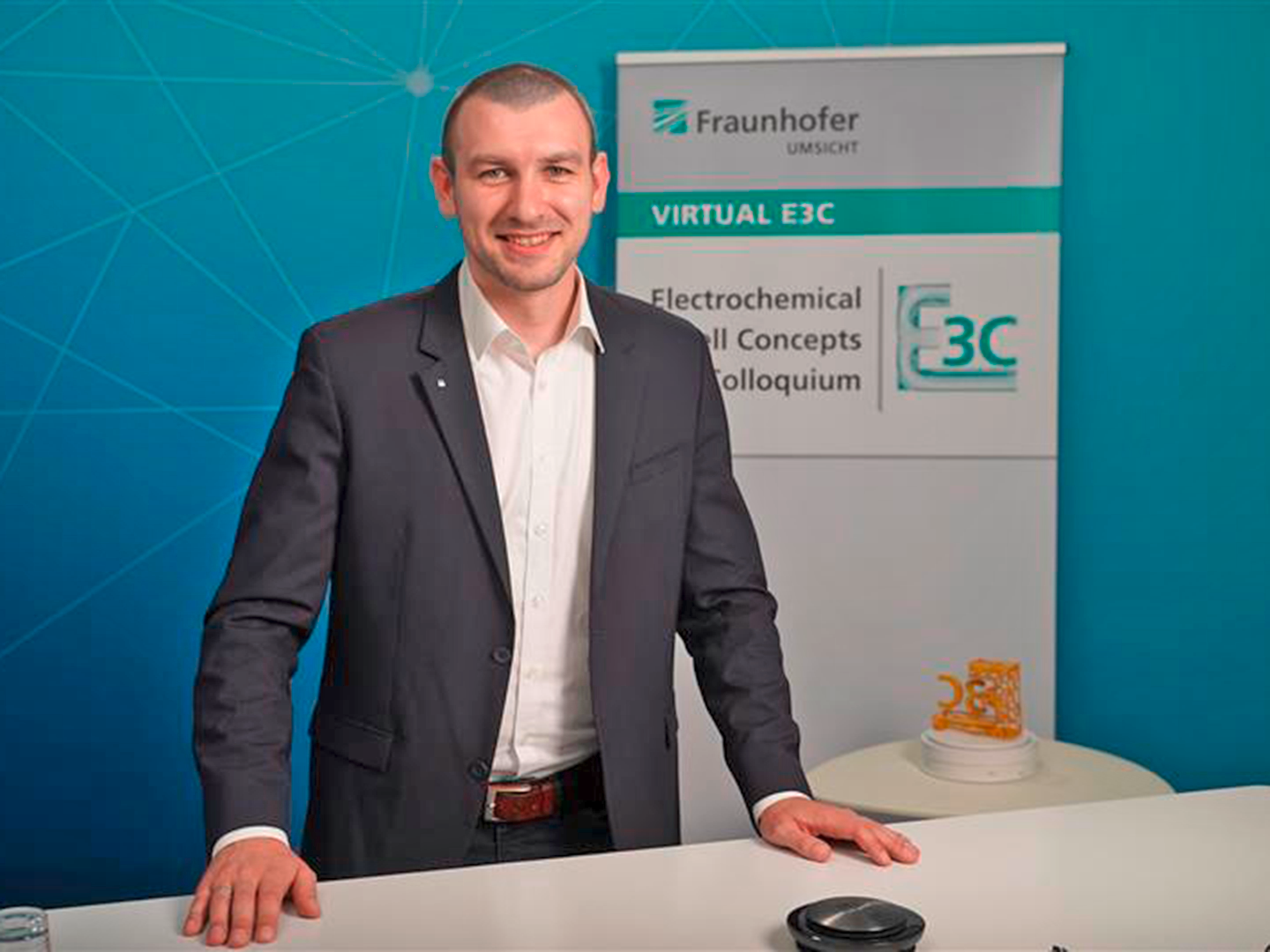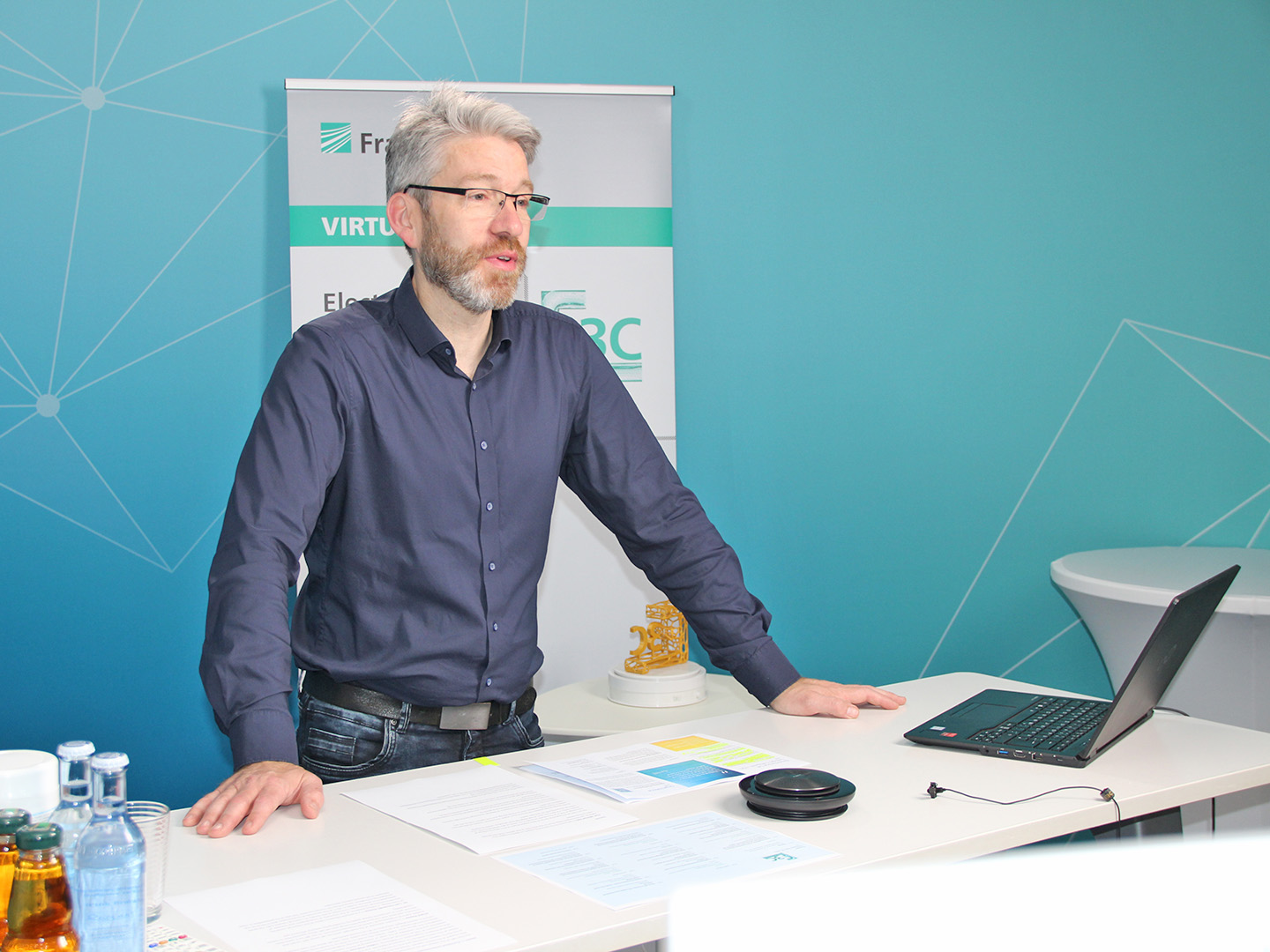Event review
At the 3rd "Electrochemical Cell Concepts Colloquium", around 100 participants discussed flow and non-flow reactors
With around 100 participants and speakers from Australia, Europe, North and Central America, the third "Electrochemical Cell Concepts Colloquium – E3C" on May 19, 2022 was a complete success. This year, the presentations and discussions focused on CO2 conversion and capture, 3D-printed electrodes and innovative cell and stack concepts.


The welcoming address by organizer Dr. Jan Girschik and Prof. Dr. Christian Doetsch, Head of Energy at Fraunhofer UMSICHT, was followed by a keynote. Prof. Dr. Michael Aziz from the Harvard University in Boston presented two current projects: on the one hand, a new electrochemical process to capture CO2 and, on the other hand, a new way to characterize flow cells using fluorescence microscopy – with the objective of visualizing the state of charge within the cells.
In doing so, Michael Aziz, referring to the first project, emphasized that electrochemical CO2 capture has recently benefited from cheap, clean electricity. But at the same time, he said, molecular evolution toward more oxygen resistance is needed for direct air capture of carbon dioxide. Regarding the second project, he said, "Porous electrodes in flow cells exhibit surprisingly large state-of-charge heterogeneities. However, using 4D confocal fluorescence optical microscopy, we should be able to image the state of charge." In addition, 3D printing of electrodes makes it possible to systematically study structure-power relationships, he said.
Session 1: Functional components of electrochemical reactors
Following the keynote, the first session of the virtual event started – moderated by Dr. Michael Joemann, Group Leader Component Development and Manufacturing in the Electrochemical Energy Storage Department at Fraunhofer UMSICHT. Nils Weber and Tobias Harhues from RWTH Aachen University took a look at two approaches for manufacturing porous electrodes with a large surface area to overcome the limitation of mass transport in electrochemical reactors. André Kayser of the Center for Fuel Cell Technology ZBT GmbH looked at increasing resource efficiency and sustainability of composite bipolar plates. Dr. Fernando Arenas from TU Clausthal spoke about mass transport properties of 3D-printed electrodes as a function of electrolyte velocity.
Session 2: CO2 -conversion and capture
The moderation of the second session was in the hands of Prof. Dr. Ulf-Peter Apfel, Head of the Electrosynthesis Department at Fraunhofer UMSICHT. He welcomed Prof. Dr. David Vermaas as the first speaker. The scientist from TU Delft has been investigating the coupling of electrochemical CO2 conversion and CO2 capture. Among other things, he has concluded that carbon capture requires a lot of energy compared to conversion and that coupling capture and conversion eliminates the energy needs required for solvent regeneration. Lucas Hoof of Fraunhofer UMSICHT highlighted in his presentation how the performance of zero-gap electrolysers can be improved in the industrially relevant CO2 conversion of syngas. Prof. Dr. Tom Rufford from the University of Queensland in Brisbane, Australia, addressed the latest advances and challenges in electrochemical CO2 reduction processes.
The following poster session, also moderated by Ulf-Peter Apfel, gave six scientists the opportunity to present their research topics and answer questions about them. The topics ranged from a planning tool for tubular redox flow battery stacks to flooding in gas-fed CO2 electrolysers.
Session 3: Characterization and optimization
The third and last session of the colloquium was divided into two parts. Led by Dr. Jens Burfeind from the UMSICHT Electrochemical Energy Storage Department, the first part started with a presentation by Dr. Oscar Miguel Cornejo Rojas. The scientist from the Mexican University of Guanajuato dealt with the electrosynthesis of hydrogen peroxide with anodic oxygen generation for wastewater treatment. Jonas Bäßler from RWTH Aachen presented the Flex-E cell – a modular and scalable flow cell for electrochemical research - while Prof. Dr. Thorsten Struckmann from HAW Hamburg spoke about tubular flow battery stacks.
The second part of the session was moderated by Prof. Dr. Julian Tornow from Ruhr West University of Applied Sciences, while the first presentation was given by Lukas Ritz from Forschungszentrum Jülich. He reported on the investigation and optimization of the mechanical deformation behavior of an existing PEM electrolysis stack. Dr. Christian Stolze from Friedrich Schiller University Jena discussed methods to measure the state of redox flow batteries and the most studied parameters: State of Charge, Capacity, and State of Health. To conclude the lecture program, Hendrik Hoffmann from the University of Bayreuth spoke about modular cells for radiographic analysis of gas diffusion electrodes in gas-consuming reactions.
Awards for David Vermaas and Jorrit Bleeker
For the first time this year, the best oral presentation and the best poster were awarded – based on a vote of the participants. These awards went to two scientists from TU Delft: David Vermaas and Jorrit Bleeker. In his poster, Jorrit Bleeker explored the question how to remove gas bubbles in an alkaline zero-gap electrolyzer using pressure swing.
In addition to the novel E3C award, a tradition from last year was also continued: Dr. Franziska Schwarz documented the event via graphic recording and created a visual protocol from text and drawing.
Graphic Recording of E3C 2022
Dr. Franziska Schwarz prepared a visual transcript of the presentations, as she did last year.
Last modified:
 Fraunhofer Institute for Environmental, Safety and Energy Technology UMSICHT
Fraunhofer Institute for Environmental, Safety and Energy Technology UMSICHT

